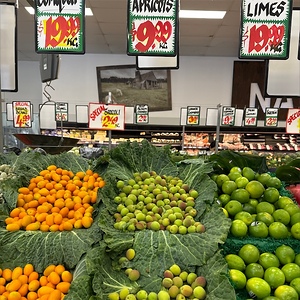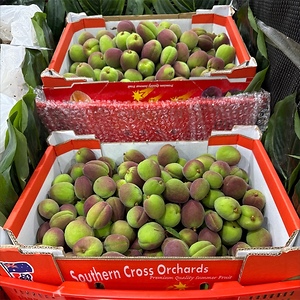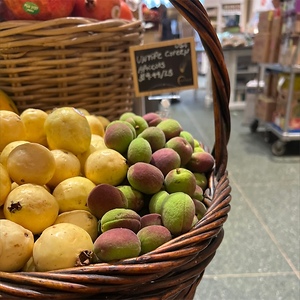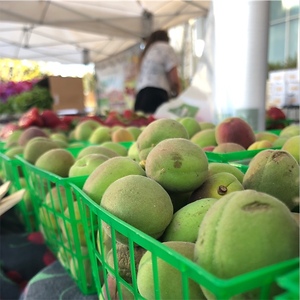

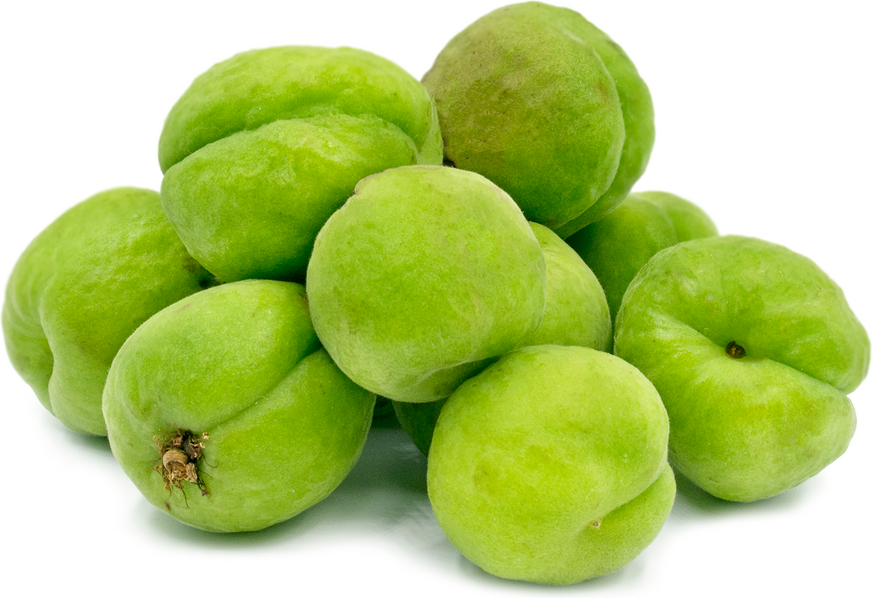
Green Apricots
Estimated Inventory, lb : 0
Description/Taste
Green apricots are typically small, averaging 3 to 5 centimeters in diameter, but their size can vary depending on the growing conditions and age at harvest. The elongated, oval fruits have smooth, curved edges and a prominent seam extending the surface length. The fruit’s skin is soft and velvety, covered in a layer of fuzz, and has a bright green coloring, sometimes covered in large patches of burgundy or crimson hues. Green apricots are firmer than their ripe golden counterparts and have a crunchy, slightly fibrous, and chewy texture. There is also a small brown pit encasing a seed, referred to as a kernel, that should be removed before consumption. The pit is located in the center of the fruit. Green apricots are edible raw or cooked and typically have a sour, acidic, lightly bitter taste with green, nutty nuances.
Seasons/Availability
Green apricots are available in the early spring and summer.
Current Facts
Green apricots, botanically classified as Prunus armeniaca, are unripe fruits belonging to the Rosaceae family. Apricots are a widespread species traditionally cultivated for their ripe, sweet, and sugary golden orange fruits. Green apricots are the young versions of the fruit harvested before they have changed colors and developed their concentrated sugar content. Historically, Green apricots were a by-product of farmers thinning their trees by hand early in the season to allow fruits to grow to larger sizes. These picked green fruits were either eaten by the grower, given to friends and family, or discarded. As cultivation progressed, growers began selling these unripe, sour fruits as a specialty product. Green apricots are only found for a short season and are a rare fruit valued by chefs and consumers for their tangy flavor and firm consistency. The fruits are some of the first to appear in markets in the spring and are primarily utilized throughout the Middle East and Central Asia. Green apricots are a seasonal delicacy known under varying names, such as Dovcha in Uzbekistan, Dura in Tajikistan, Qaraoun, and Khubani, Khurmani, Khumani, Jardalu in India. It is important to note that apricots do not ripen off the tree and will retain the same flavor as when picked. Green apricots are known for their sour, bitter taste and are incorporated into fresh and cooked preparations.
Nutritional Value
Green apricots have not been extensively studied for their nutritional properties. Apricots, in general, are a source of fiber to regulate the digestive tract and act as a natural method to cleanse the body. Apricots also provide vitamins A, B, C, and K to aid in faster wound healing, strengthen the immune system, produce energy, and maintain healthy organs. Other nutrients include minerals like magnesium, phosphorus, potassium, iron, copper, calcium, and zinc. Magnesium helps the body control daily nerve functions, phosphorus and calcium support bones and teeth, and copper develops connective tissues. Iron produces the protein hemoglobin for oxygen transport through the bloodstream, and zinc contributes to DNA production. In Central Asia, Green apricots are sometimes chewed to freshen the breath.
Applications
Green apricots have a green, acidic, subtly bitter, and sometimes nutty taste suited for fresh and cooked preparations. The unripe fruits are traditionally sprinkled with salt or chili powder as a crunchy snack, and the seasonings help to balance their acidic nature. Green apricots are commonly seen in markets in large fresh piles when in season, especially in their growing regions. Consumers purchase handfuls of small fruits and often eat them raw with seasonings, or they can also be combined with other spices and herbs in salads and side dishes. Green apricots are simmered into jams and syrups with added sugar or cooked into various savory sauces and chutney. In India, Green apricots are chopped, sometimes ground, and simmered in aromatic spices to create spicy, flavorful condiments for any meal. Green apricot chutney is a favorite condiment for biryani. Sauces are also made throughout Eastern Europe with Green apricots, like tkemali sauce, a Georgian recipe. This sauce is traditionally made with plums, but Green apricots are often used instead of unripe plums. In the Middle East and Northern Africa, tagine-based meals sometimes incorporate Green apricots and are popularly served with poultry and lamb. Green apricots are also simmered into soups or pickled as a tangy ingredient. Try serving pickled Green apricots on appetizer plates to add salty flavors. Green apricots are also steeped in shochu and other liquors as a variation of umeshu, a Japanese wine typically made with plums. Green apricots create a flavor similar to plums in the drink and are a favored substitute in regions where the Japanese plums are unavailable. Green apricots pair well with herbs such as coriander, mint, and parsley, spices including cinnamon, cloves, nutmeg, and cardamom, lemon, and vanilla. Whole, unwashed Green apricots should be stored in the refrigerator, where they will keep for 5 to 7 days. Pickled Green apricots will last for several months to years.
Ethnic/Cultural Info
Apricots are a part of a famous saying commonly used in Arabic-speaking regions. The phrase roughly translates from Arabic to “bukra fil mish-mish,” meaning “when the apricots are in season” or “when the apricots bloom.” This saying is used to describe something that has little to no chance of happening or is highly unlikely. Apricots are incorporated into this phrase as they are known for their fleeting, delicate nature and are hard to find in markets. The fruits are only in season for a short period each year and are easily damaged by strong winds or weather changes, further enforcing their elusive reputation. This phrase is used similarly to the English expression of “When pigs fly,” which is thought to have roots in various Scottish proverbs and writings.
Geography/History
Apricots are descendants of wild species native to regions in Asia. Scientists hypothesize that there are three possible centers of origin, including Central and Western China, Central Asia, and Asia Minor. Early types of apricots were spread across Asia through trade routes, especially the Silk Road, and the fruit’s seeds were easily carried with merchants and traders. This expansion contributed to the species' presence throughout Asia, and over time, it is thought that Asian merchants introduced the species to the Persians and Arabs, who carried and planted the fruits in the Middle East and the Mediterranean. Green apricots have been present since the species’ origin. Much of the history of the young fruits is unknown, as they are a seasonal specialty harvested on a small scale as a culinary ingredient. Today, Green apricots are grown worldwide and are available in limited quantities directly through growers or select fresh markets. Green apricots are mainly found in Central Asia, China, India, the Middle East, the Mediterranean, and Northern Africa markets.
Recipe Ideas
Recipes that include Green Apricots. One
| Venturists |
|
Chicken Tagine with Apricots, Prunes and Preserved Lemon |
| Food & Wine |
|
Pickled Apricots |
Podcasts



